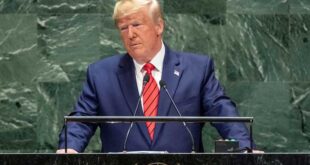Giancarlo Elia Valori
On October 20 last the US President, Donald J. Trump, stated that North America would withdraw from the INF Treaty on nuclear missile weapons, which means that Europe will be again the main base for the new intermediate and long-range weapon systems.
Obviously the European ruling class, both at national and EU levels, has not yet said a single word about this new configuration of the threats and defences on our territory.
President Trump referred specifically to the 1987 INF Treaty or, more precisely, to the Intermediate-Range Nuclear Forces Treaty, signed by Ronald Reagan and Mikhail Gorbachev in 1987 – a treaty that, in particular, banned the ground-launched nuclear missiles having a range between 500 and 5,500 kilometres.
The INF Treaty led to the complete elimination of almost 2,700 medium and short-range missiles, including 850 US ones and over 1,800 Soviet ones. As many may recall, it put an end to the tension between the United States and the Soviet Union just at the time when the latter deployed the new SS-20 missiles in Eastern Europe and, as a response, the former deployed its Cruise and Pershing missiles in the European NATO, in a phase characterized by a whirlwind of “pacifist” demonstrations.
The “Euromissile battle”, as it was defined in the extraordinary book La Bataille des Euromissiles by Michel Tatu, was the real beginning of the end of Cold War.
Nevertheless, it was a leader of the Milanese Communist Party, who was like one of the family in the Soviet Union, who personally informed the German Social Democrat Chancellor, Helmut Schmidt, that the Soviet SS-20 missiles had an eminently offensive function.
If there had been only the Soviet SS-20 missiles aimed at European targets, not necessarily only military ones, the remote conditioning of our defence and economic policy would have been almost complete.
Hence the “Euromissile battle” was the real and last battle for the freedom of Europe which, before the Soviet missiles, had undergone almost twenty years of ideological conditioning, which had begun in 1968 and had been turned into a real low-intensity civil war, in Italy in particular.
In that case the pro-Soviet propaganda or, in principle, the “pacifist” propaganda had the last glimpse of life and, above all, huge support by Soviet Union and its various parallel propaganda organizations.
Those were the last days in which the old techniques of political propaganda still operated – between “the partisans of peace” and the Catholics of “dissent” – invented by the German Communist, Willi Muenzenberg, the “Stalin’s propaganda agent” and the organizer of many Communist communication battles.
However, let us revert to President Trump and the INF Treaty.
In fact, the US President states that Russia has actually infringed the INF Treaty rules, as it has developed a new type of medium-range missile.
However, as we will see at a later stage, faults are equally divided between the two contenders.
He refers to the 9M729 missile, in particular, also known as SSC-X-8.
It is a missile having a medium-long range – 3,000 nautical miles – which is supposed to be the land version of the SS-N-30 missile.
The missile is equipped with a starting solid propellant, which fires after the launch. The control system and guidance of the cruise missile is inertial control system (autopilot) with Doppler sensors drift angle correction according to the Russian GLONASS and Western GPS satellite navigation systems.
If launched from the Siberian coast, this Russian missile could easily reach the Californian coast up to Los Angeles.
If launched from Moscow, however, it could cover the whole Western European area.
It is likely, however, that in a new treaty Russia wants to negotiate the elimination of the NATO ground-launched missiles in exchange for the abolition of its ones, thus excluding – from the negotiations for the reduction of strategic weapons – the newly developed long-range missiles and the hypersonic ones, of which we will speak later on.
The next race for new weapons will be focused there.
Over the last few days, however, both Trump and Putin have declared to be ready for dialogue, also with a future informal meeting in Paris, as had been recently decided during the visit paid by President Trump’s National Security Advisor, John Bolton, to Moscow where he met President Putin.
On March 1, 2018, however, President Putin had stated Russia had already developed and making operational a new complete line of medium-long range strategic missiles, capable – above all – of quickly getting the North American and NATO missile defences out of play.
Putin mainly made reference to missiles, but also to underwater drones and other types of advanced weapons, all arms systems that the Russian Federation has developed since the US withdrawal from the Anti-Ballistic Missile Treaty (ABM)) signed with the USSR in 1972.
The American withdrawal, however, dates back to December 2001.
In his demonstration, Vladimir Putin showed two new weapon systems, the RS-28 Sarmat (NATO reporting code: SS-X-30 Satan 2), which has an average range of 11,000 kilometres, and another innovative missile about which we will talk later on.
It should be recalled that the Satan 2 missile was designed in response to the deployment of the US GMD anti-ballistic missile systems and the subsequent launch of the US Defence program called Prompt Global Strike in 2009.
At least for the time being, the GMD is deployed in military bases in the States of Alaska and California and comprises 44 kinetic interceptors (40 in Alaska and 4 on the Western coast in the Los Angeles area) for intercepting incoming warheads in space, during the midcourse phase of ballistic trajectory flight. It spans 15 time zones with sensors on land, at sea and in orbit.
The GMD positions are supposed to reach 100 by the end of 2020.
The concept of US missile defence, however, is based on the maximum possible redundancy of signals and counteractions, at different altitudes, so as to permit a significant response, even after a severe nuclear missile attack.
The second strike is the basic concept of every ABM defence, both in the USA and in the rest of the world.
The radars for the interceptor networks are mainly located in Pearl Harbor, in relation to the inevitable routes of the Chinese ICBMs, but with the radars for early signalling also deployed in Alaska, Great Britain, Greenland, Qatar, Japan and Taiwan – while the data collected by both fixed networks and aircraft is processed in the Schriever airbase located in El Paso County, Colorado.
It should be noted that the current US system is mainly designed to counter missile attacks by States such as North Korea and Iran, while it is not specifically calibrated to respond to “well-established” strategic forces, such as Russia or China.
In fact, there is no missile shield capable of successfully countering a stratified threat that is put in place by a real nuclear State.
Incidentally, the yearly cost of the Missile Defense Agency for 2018 amounts to 7.9 billion dollars.
Conversely the Prompt Global Strike program is a system that can deliver a precision-guided conventional weapon airstrike anywhere in the world within one hour since the President’s order or since the detection of the threat. It is expected to become operational this year.
It has been calculated that this project can make the United States spare at least 30% of its nuclear weapons.
An additional implementation of the strategic redundancy criterion.
Russia, however, responded to this US project with one of the missiles mentioned by Vladimir Putin together with the Satan-2 missile, namely the S-500 Prometey, also known as the 55R6M Triumfator M.
The S-500 is designed to destroy both new generation long-range missiles and hypersonic cruise missiles and has a minimum range of 600 kilometres up to 3,500.
Hence it falls within the scope of the old INF Treaty.
It has a speed of 5 kilometres per second and it is supposed to be operational by the end of 2020.
It is by no mere coincidence that Putin delivered his speech shortly after the release of the Pentagon’s New Missile Doctrine, namely the Nuclear Posture Review, in which an attempt is made to make the new generation anti-missile defence policy line more comprehensive and up-to-date vis-à-vis Russia, China and, as usual, North Korea and Iran.
The logic underlying this Pentagon’s official document is simple: if the USA increases its nuclear war potential, the Russian Federation will automatically be deterred from planning a missile attack against the US territory.
Moreover, Putin also stated that new laser weapons are under construction and that a new hypersonic missile is also ready, namely the Kh-47M2 Khinzal (“Dagger”), an air-launched ballistic missile specific for the MiG31BM interceptors.
Russia has also the brand new RS-26 Avangard, a hypersonic missile equipped with Multiple Independent Targetable Reentry Vehicles (MIRVs).
In short, the two countries that signed the IFN Treaty have resumed the nuclear and ABM arms race.
It was a bad surprise for the United States to discover a technologically advanced and a doctrinally evolved Russia both in the Crimea operation and, particularly, in the actions to support Bashar al-Assad’ Syrian Arab Army.
Hence the periphery is hit with remote control weapons to signal to the centre – be it Russia or the USA – the need to quickly give up that area, that technology, that specific economic, energy and technological presence.
This is the deep logic underlying conventional or nuclear missile systems.
Obviously this applies to both Russia and North America.
Furthermore, considering the Russian technological evolution, the USA plans to resume the arms race not only to weaken the growing Russian economy, but also to combine China’s and Russia’s ICBM threat with the other asymmetric and unpredictable missile threats of Iran and North Korea.
This means that the United States still wants the complete regionalization of the Russian Federation and its encirclement between the NATO-led Eastern Europe and the US-led Central Asia, to control both China’s and Russia’s borders.
The fewer conventional forces are, the greater the remote threats of advanced weapon systems must be – and this is also a common logic for both major players.
Sealing China into its own borders, which have always been insecure, means permanently stopping the Belt and Road Initiative and halting its economic, technological and financial development.
Hence nuclear missiles are the ideal power multiplier for a global attack and defence strategy.
What about China? What policy line does it have for its nuclear ABMs? Meanwhile, China always publicly reaffirms its three classic principles: no first use of the nuclear weapon; no use of the nuclear weapon against a non-nuclear country; maintenance of an arsenal only capable of minimum deterrence, just to ensure the possibility of a second effective nuclear response to an attack.
At statistical level, China is currently supposed to have approximately 280 nuclear warheads, to be used on 120-130 ground-launched ballistic missiles – 48 to be used on ships or submarines and the rest with air carriers.
Nevertheless, once again in response to the ABM and nuclear missile evolution of the United States in recent years, China has added many multiple warheads to its intercontinental ballistic missiles, especially the ground-based ones.
In this case, the “MIRVization” – i.e. the allocation of multiple weapons for each carrier – would also imply a new ability to penetrate the US missile lines, not only for defence purposes.
However, to what extent are missile defences really effective and to what extent is a conventional or nuclear ballistic attack system precise?
With specific reference to the United States, about half of the 18 tests carried out so far for intercepting an enemy missile have failed.
On the best possible assumption, the operational interception made by the ABM systems works only in 50% of cases.
The aforementioned GMD, which already costs 40 billion US dollars, has not yet been tested in sufficiently realistic conditions.
For example, if we consider an attack with five missiles and four interceptors for each target, considering that each interceptor works exactly in 50% of cases, the probability that a missile penetrates the defence network is 28%. Too much.
Every nuclear or conventional attack is such as to make the attacker win.
However, what would happen if there were – as it might be very likely – a concerted attack by various different missile systems, each with a different system of targets and defensive covers?
Hence the danger of a saturation of the US defence systems is extremely high.
They would be grappling with different types of attack, different technologies and different logics for selecting targets.
Every enemy’s successful nuclear attack can be the one determining the final victory. With this particular strategy, the attacker has almost always the victory in his bag.
However, reverting to the end of the INF Treaty, now decided by the United States, it should be noted that, according to the US State Department, as early as 2014 Russia has repeatedly infringed the Treaty.
In December 2017, the US intelligence services identified the Russian short-range 9M729 missile which, however, precisely follows the INF rules.
Nevertheless, the Unites States maintains it violates the Treaty anuway.
It is the United States, however, that has clearly infringed the INF Treaty with its Mark 41 Vertical Launch System and with the manufacturing of drones which are, in effect, cruise missiles in disguise.
Moreover, in recent years China, in particular, has developed many new-design missiles that operate precisely within the range explicitly prohibited by the INF Treaty, namely between 500 and 5,000 kilometres.
It should be recalled that China has never signed the INF Treaty.
Although being often urged to join the INF Treaty, China has always refused to sign it.
Hence, while Russia is modernizing its conventional and nuclear missiles, this implies a clear doctrinal, strategic and technological cooperation with China.
However, if there were a simultaneous attack from China and the Russian Federation, it would be unlikely that the North American ABM networks could protect the whole US territory.
Not to mention Europe, which currently deals only with currencies, without having clear in mind – even in this case – what the real issue at stake is.
 Geostrategic Media Political Commentary, Analysis, Security, Defense
Geostrategic Media Political Commentary, Analysis, Security, Defense





